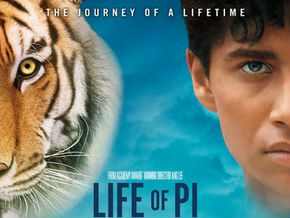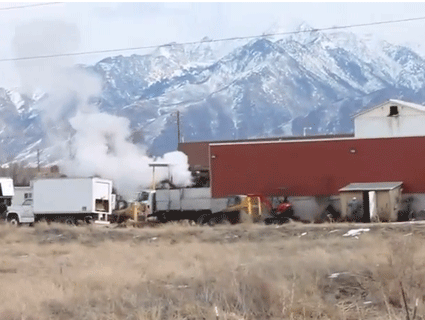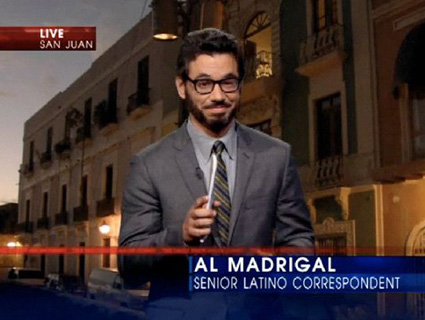Update: Kentucky officials had previously warned Call of the Wildman‘s star that he was breaking the law. Read more.
By the time three orphaned raccoons arrived for emergency care at the Kentucky Wildlife Center in April 2012, “they were emaciated,” says Karen Bailey, who runs the nonprofit rehab clinic set in the sunny thoroughbred country just outside of Georgetown, in central Kentucky. “They were almost dead.”
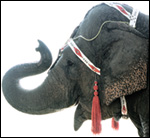
A fast talker with ashy blond hair and an easy laugh, Bailey is a newborn raccoon specialist. She also takes in injured or abandoned opossums, otters, and skunks. Though she cares for up to 800 animals every year—including around 300 baby raccoons—she is haunted by the memory of those three gaunt cubs.
These weren’t just any raccoons. They were the stars of one of the highest-rating episodes of Call of the Wildman, the hit Animal Planet reality TV show.
When cubs are in such bad shape, Bailey says, “It’s a race against time.” The animals were incubated and intubated, fed fluids and antibiotics. As a last-ditch effort, Bailey administered blood plasma and managed to save two of the raccoons—”a miracle.”
“Guided Reality”
With a marquee Sunday night slot, Call of the Wildman regularly attracts more than a million viewers; for the fourth quarter of 2011, it was the network’s most-watched series. When the episode about the raccoon cubs, “Baby Mama Drama,” aired in July 2012, it pulled in 1.6 million viewers to become the show’s highest-rating episode up to that point. Thanks in part to Call of the Wildman, Discovery Communications, Animal Planet’s parent company, was among the top three fastest-growing ad-supported cable networks in 2012. The trend continued in 2013.
With three seasons under its belt, Call of the Wildman is part of Animal Planet’s ongoing shift away from educational programming to reality TV. “We’re not looking to be a natural history channel,” Animal Planet group president Marjorie Kaplan told the New York Times in 2008. “We’re looking to be an entertainment destination.” The network recently aired two documentary-style programs purporting to present evidence that mermaids are real.
For Call of the Wildman, Animal Planet teamed up with a production company called Sharp Entertainment, which specializes in what has become known as “guided reality”: shows that unearth outlandish characters and heavily produce their stories. Other hits in its catalogue include Doomsday Preppers, Punkin Chunkin (about the cult sport of catapulting pumpkins), and Extreme Couponing. Call of the Wildman follows the exploits of Ernie Brown Jr., a.k.a. “Turtleman,” a wily wildlife rescuer from Lebanon, Kentucky, “armed with country wits as sharp as the steel blade he carries.” Wearing a broad-brimmed hat and displaying a toothless grin, Turtleman captures critters causing headaches for homeowners or businesses, with his buddy Neal James in tow—and always with his bare hands.
Animal Planet’s parent company, Discovery Communications, states, “Our commitment to creative and innovative programming is matched only by our steadfast commitment to honesty and integrity in everything we do,” and that Discovery expects contractors “to comply with similar ethical and legal standards.” But the raccoon incident is just one of numerous instances on Call of the Wildman sets of alleged animal mistreatment and possible infringements of state and federal law, the result of what sources describe as cavalier and neglectful production practices. A seven-month Mother Jones investigation—which drew on internal documents, interviews with eight people involved with the show’s production, and government records—reveals evidence of a culture that tolerated legally and ethically dubious activities, including: using an animal that had been drugged with sedatives in violation of federal rules; directing trappers to procure wild animals, which were then “caught” again as part of a script; and wrongly filling out legal documents detailing the crew’s wildlife activities for Kentucky officials.
When asked about these allegations, Animal Planet arranged for an interview with Sharp Entertainment that also included Matthew Hiltzik, a top Manhattan crisis manager who has worked for celebrities like Justin Bieber. The producers said that they have investigated allegations of animal mistreatment that were brought to their attention last May by a staffer. “We’ve always made the humane treatment of animals our top priority,” says Dan Adler, a Sharp senior vice president.
Sharp says that after the allegations came to light, it introduced new written guidelines for the field crew, and, for the first time, hired an on-set licensed animal handler when shooting began again around May 22 last year.
Yet Adler said the network has no intention to pull the episodes in question, which are still available for download and in reruns. “What we found out about in those investigations made us feel comfortable with airing the shows,” he says. Sharp didn’t see fit to fire any employees as a result of the investigation.
In that interview and in follow-up emails, the producers admitted that some animals had been improperly handled, but blamed most wrongdoing on subcontractors. “The person who is providing that animal for production is responsible for adhering to those legal requirements,” says Patricia Kollappallil, senior vice president for communications for Animal Planet.
The Raccoon “Rescue”
In the raccoon segment, Turtleman’s challenge is to trap an animal that is terrorizing a Kentucky family and, we’re told, may carry rabies. The voiceover warns, “Turtleman’s investigation is this critter’s last chance to avoid an untimely death.”
Brown and James locate the animal in the laundry room and, in a dramatic catch sequence, Turtleman roughhouses and bags it. He then learns the real problem: “Fluffy doesn’t have rabies—she’s got babies!” With much hammy suspense, Turtleman carries the caged mother around like a metal detector, trying to get her to call to her cubs under the house. As always, there’s a happy ending—mom and cubs safe at a wildlife sanctuary, a family no longer under siege: “We had no idea that there was babies underneath the house. That was such a surprise!” homeowner Tina Merrick says on camera.
In fact, as with much of high-drama reality TV, the segment was concocted. Michael O’Bryan, the vet at Broadbent Wildlife Sanctuary, where the raccoons were taken to be filmed after the rescue, told me the “mother raccoon” was actually a male. (Sharp told me they “cannot affirm with certainty the gender of the raccoon.”)
Three sources involved with the show confirmed that producers typically procure animals from farms or trappers and put them in fake rescue situations, on sets tailored to specification.
Sharp producers even go so far as to make fake animal droppings using Nutella, Snickers bars, and rice.
“It was part of my job to call around people to trap animals at the direction of Sharp,” says Jamie, who worked on the show. (Jamie’s name has been changed. Sharp Entertainment requires many employees and participants to sign confidentiality agreements that call for as much as $1 million in damages if breached.) “It’s 100 percent fake,” said a second production source.
In other words, the raccoons were not “found” under the house, nor reunited with their mother. They were performers in a Call of the Wildman script.
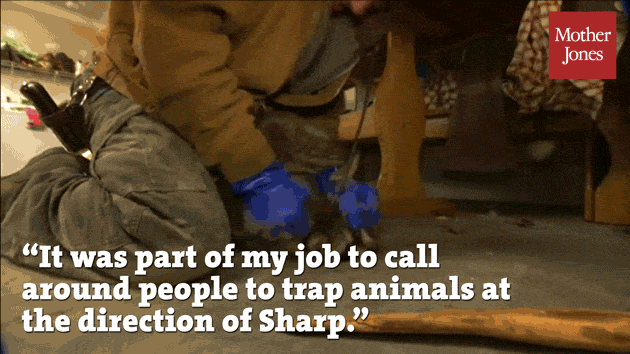
Animal Planet and Sharp admit to staging rescues, but prefer to view their use of animals in a kinder light, arguing that the animals used in the show—many of them rescued by licensed wildlife officers as part of their regular work—might otherwise be euthanized. Call of the Wildman gives them another chance. “We take pride in the fact that many of these nuisance animals in the state of Kentucky would be exterminated when caught, but the animals featured in Call of the Wildman are relocated,” Adler says. “And that’s an important part of the show for us.”
Sharp says it’s against their policy to hire people to trap animals. But my production sources say that the show didn’t happen to come into the possession of rescued animals just in time for these elaborate setups: It actively sought specific species to be placed on sets and chased by Turtleman, in scenes that sacrificed the well-being of the animals for entertainment. Records pertaining to trapping and transport procured by Mother Jones confirm the practice of commissioning people to hunt for animals, and paying for their services.
“We paid a trapper to put cages around the state, and wherever else they came from, and then caged them for multiple days, and then put them in an enclosed setting and had Ernie…capture them,” said a source involved with the show.
For his part, Ernie Brown Jr. told Channel Guide Magazine in 2011 that “people have been calling me fake, and there ain’t no fake…I’m catching animals, that’s the way it is.” But internal production documents show that Call of the Wildman is tightly staged. “We would basically pitch the entire script that was sent to Animal Planet weeks ahead of time with the exact animal, and location,” said Jamie. “They knew.”
“Ninety-nine percent of the show, even the dialogue, was scripted, for Ernie to say,” said another source.
Indeed, a disclaimer—”the preceding program contains some dramatizations”—appears at the end of the show from episode 13 onwards. “Any time you’re filming in film or television, you go to a location and you make adjustments to be able to accommodate your film crew and whatever your storyline is,” says Kollappallil, from Animal Planet. Sharp told me in an email that, “It is Call of the Wildman policy that these dramatizations are conducted legally and humanely.”
But our investigation suggests that the show goes far beyond “dramatizations”—which implies restaging real events—to full-blown fabrication. After a segment that aired in early June 2013 depicted Brown fishing poisonous cottonmouth snakes out of a public pool in Danville, Kentucky, city authorities investigated. They concluded that the scene was manufactured: “Let me put it this way, they [the snakes] didn’t crawl in or swim” into the pool, the report quoted pool manager Harold Logue as saying. City Manager Ron Scott told me that the city received no response to the report from Sharp or Animal Planet.
“My biggest issue with the show was that we portray it as: We rescue animals,” said one of the sources. “In my opinion, the animals weren’t under stress until we arrived.”
In the case of the baby raccoons, Animal Planet and Sharp say they received the animals no more than 48 hours before filming, and adapted the script at that point to include the cubs. But the phone records of baby raccoon expert Karen Bailey show that a Sharp producer, Ed Ryan, contacted her several days ahead of the actual filming. (Ryan declined to comment on the record.) According to Bailey, when producers told her they had the baby raccoons, Bailey says she warned that holding them without their mother or proper care put them at fatal risk, and she volunteered professional help.
They said she could help them—but on their terms: “They made it very clear that the only way that we would have access to these babies is if we agreed to the filming” of the final scene in her clinic, she says. Not wanting to be associated with the show, Bailey helped negotiate a new location at Broadbent Wildlife Sanctuary. But by the time filming wrapped, the cubs were so sick that Broadbent staff took them to Bailey.
Kentucky Wildlife Center intake chart:
Animal Planet and Sharp say the raccoons featured in the episode were brought to producers in two groups, from two separate nuisance calls. But legal wildlife documents filled out by Sharp on behalf of Turtleman don’t back up that claim.
Turtleman is a licensed Nuisance Wildlife Control Operator (NWCO) in the state of Kentucky, a qualification that allows him to trap and handle animals for money and requires him to report all captures to the state’s Department of Fish and Wildlife Resources. Entries written under Ernie Brown Jr.’s name for the raccoons, obtained through an open-records request, suggest that all four raccoons were caught on the same day—April 11, 2012—then all “released to private acreage” (rather than to a rehabilitator).
Animal Planet calls the entry a “clerical error.”
“Staff members are aware those are meant to be filled out accurately,” Adler says. “So if it’s a mistake, it’s a mistake.” The department says that knowingly providing false information on these reports is grounds for permit revocation.
A page from Turtleman’s NWCO reporting form:
In another incident raising questions about the show’s compliance with state rules, a wallaby was transported across state lines. Sharp says that the animal’s handler told them she had the correct permits, but an open-records request reveals that no transportation permit for the wallaby was issued. Nicole Paquette, vice president of wildlife protection for the Humane Society of the United States (HSUS), says that moving the wallaby across state lines without a proper permit—especially for commercial purposes—could also violate federal regulations on interstate trafficking of wildlife.
In any case, John Griffin, the director of Humane Wildlife Services at HSUS, says that the state rules for nuisance wildlife operators weren’t designed for this kind of situation. “It’s not the intent of it to provide entertainment,” he says. “You’re really introducing a new conflict, and it’s way outside of what’s allowed.”
Bailey says it’s possible the raccoon cubs could have died in the wild. But once they were in the show’s possession, she says, every additional hour away from proper care put them in greater danger. “If these animals were somehow subjected to someone’s production schedule, somebody’s convenient timeline, and you’re dealing with newborn animals that need round-the-clock care—then that’s wrong,” she says.
Kentucky law prohibits wantonly failing to provide adequate food, drink, or health care to an animal. The Animal Legal Defense Fund has ranked Kentucky as the worst state in the country for animal protection for the last seven years in a row, in part because of weak enforcement.
Bats in The Hair Salon
Documents and sources also raise troubling questions about a segment shot at Jazzy Girls, a brightly painted storefront in Houston’s fashionable Montrose neighborhood, in April last year. “A mysterious skittering sound in the storage room has been terrorizing the hairdressers,” says the voiceover in “Bat Hair Day,” which aired in early August. Turtleman is invited by the owner, Velma Trayham, a.k.a. “Coco the CEO,” to “uncover the culprit before business goes belly-up.” Then, Turtleman “discovers” a group of Mexican free-tailed bats.
Animal Planet and Sharp acknowledge that the bats were placed in the salon for the purpose of filming, but they claim that it happened legally. “Everyone involved in the production of Call of the Wildman is aware to follow all the laws, state and federal, and they know that they have to abide by them for every aspect of the production,” Adler says.
Texas law allows people to remove bats from their homes or businesses, though Jonah Evans, a biologist with the Texas Parks and Wildlife Department, told us that bringing a bat to a new location for entertainment purposes alone is not allowed.
In the weeks after the shooting, documents show, Animal Planet contracted a pest control company to remove dead bats from the salon. Sharp says only one dead bat was recovered, and that it was a different species than the bats they brought in. But Jamie and another individual with direct knowledge of the arrangement say that a pest control company was required at least twice, and Mother Jones has seen documents indicating that Sharp paid for bat removal service on two separate occasions; both sources say one dead bat was definitely the same species as the bats Turtleman chased. During the filming of the episode, Turtleman is shown sealing the gaps in the salon walls shut with tape so the bats can’t escape during the “rescue.” High slapstick ensues as he flounders to catch the animals with his bare hands and the staff obliges with screams. (Trayham declined to be interviewed. The salon has since closed.)
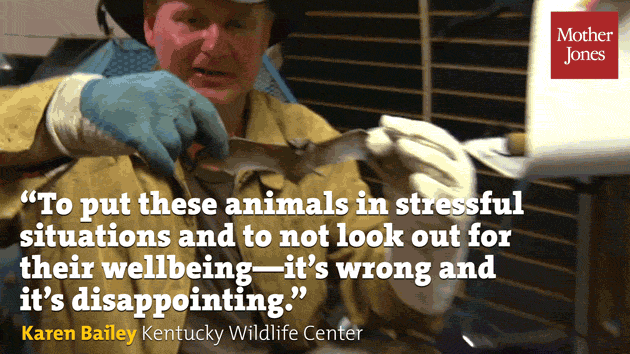
The Woozy Zebra and the “Wild” Mink
In another Texas-based episode, “Lone Stars and Stripes,” Turtleman chases a zebra that has supposedly escaped from its fenced-in yard at a ranch. He rides in hot pursuit of the animal in the flatbed of his pickup, brandishing a lasso; eventually he corners the zebra and tackles it.
But behind the scenes, things were far murkier. Production sources told me that the zebra seemed woozy during filming; it could barely walk. Animal Planet and Sharp obtained the zebra from the Franklin Drive Thru Safari, an animal park run by a businessman named Jason Clay. In a phone interview, Clay confirmed that he supplied the zebra, but denied using sedatives. Clay is licensed under the federal regulations for animal exhibitors, which specify that “drugs, such as tranquilizers, shall not be used to facilitate, allow, or provide for public handling of the animals,” and that handling of animals should not cause trauma, behavioral stress, physical harm, or unnecessary discomfort.
Despite Clay’s denial, Animal Planet and Sharp confirmed to Mother Jones that the zebra was drugged before filming, but they say it happened behind their backs. However, Jamie and other sources say that the crew was aware of the zebra’s sedation during filming, especially since the animal nearly fell over several times. “I heard about the zebra being almost unusable,” says another source. “They sedated it, to get it to be less crazy.” Another confirmed that the zebra looked “out of it.” Animal Planet admits that producers used an additional, unsedated zebra for supplemental footage.
“It’s a damn bullshit show,” Clay says. “You know it, and I know it. It’s just entertainment, cheap entertainment. It gives everybody a job or something to do.”
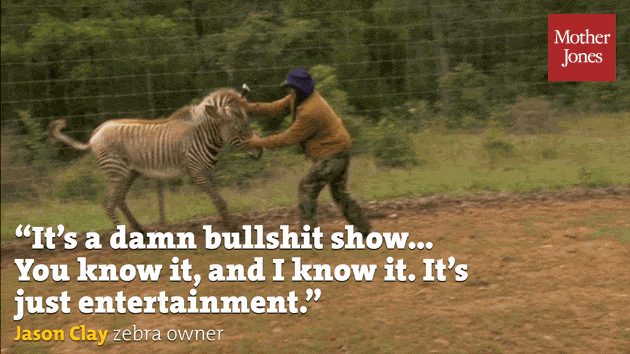
On movie sets, union rules require animal handlers to be monitored by the American Humane Association, which bestows the coveted “No Animals Were Harmed” disclaimer. (The group was the subject of a recent investigation by Hollywood Reporter, which describes AHA’s resources as stretched thin, even for the shows they do monitor.)
But AHA supervision is not required on nonunion sets, and the group says Call of the Wildman has never invited the group to monitor animals. Sharp says that it now employs an animal handler with a USDA exhibitor license to enforce its new guidelines, which it made available to Mother Jones.
But prior to these changes, say the sources, Animal Planet asked untrained staff members to handle animals and to make ethical judgments about using them. In one episode, Turtleman is called in to track down a mink vandalizing a putt-putt course in Lexington, Kentucky. Because of scheduling issues, the mink was kept caged for up to a week at the home of a local production staffer, Will Johnston, according to two sources who worked on the show. Johnston declined to comment. Animal Planet confirms the mink was not Johnston’s pet.
Sharp said in a statement that, “It has always been COTWM policy that show staff not be asked to handle the animals on a production. Prior to season three, occasionally, staff members were asked to supply food or water or to accompany a licensed officer in the transport of animals.”
But the new policies, say members of the show’s crew, may not fix all the problems with the show’s animal-handling culture. “I think the entire model is wrong,” said one of the sources. “I don’t think the needs of production trumps the needs of both the environment and the ethical treatment of these animals.”
In the end, says Bailey, “so many people look up to Animal Planet. They remember the old Animal Planet that was dedicated to true education about animals and conservation. But to put animals in harm’s way, to put these animals in stressful situations and to not look out for their wellbeing—it’s wrong and it’s disappointing.”

